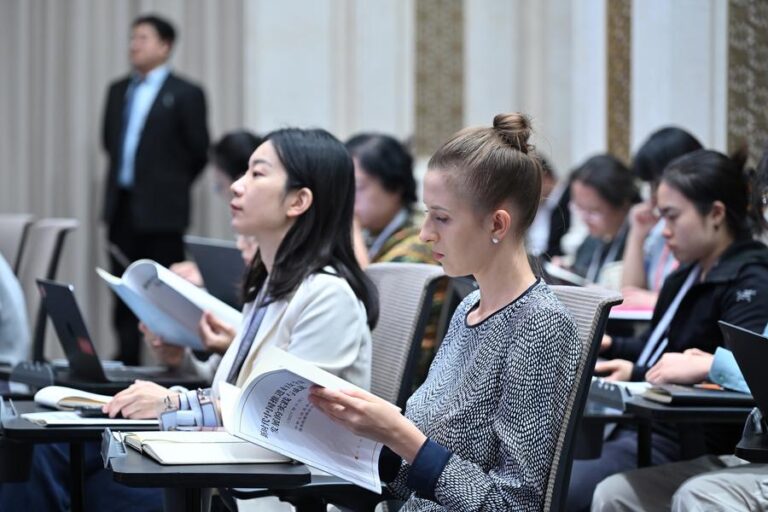BEIJING, Oct. 12 (Xinhua) — While millions of Chinese spent the eight-day National Day holiday travelling and shopping, Zheng Wenjing led her team in the fields, carefully selecting special rice seeds for her breeding research.
She likens the work to sifting sand for gold, and in early October, rice fields in northeast China began yielding a bountiful harvest.
“Every year at this time, we spend the holiday in the rice fields because it is the golden period for seed selection. It is fulfilling to be able to find high-quality materials for cultivating new rice varieties with excellent yields,” said Zheng, 51, whose work has helped tackle critical challenges such as molecular breeding of japonica rice resistant to rice blast.
“There are not many women in rice breeding because the work requires long hours in the field,” she added.
From the laboratory to the field ridges, and from basic research to the front lines of engineering, Zheng has become a model of the growing number of Chinese women contributing to sci-tech innovation, supported by the country’s institutions and policies.
Data show that China has roughly 40 million female scientific and technological workers, making up 45.8 percent of the total, a testament to the popular Chinese saying that “women hold up half the sky.”
According to a white paper titled “China’s Achievements in Women’s Well-Rounded Development in the New Era,” released by the State Council Information Office on Sept. 19, China has brought in a series of measures to support female sci-tech talent in undertaking national projects and participating in decision-making, and to improve their evaluation and incentive mechanisms.
With 30 years of strenuous efforts in the agricultural research work, Zheng, deputy director of the Rice Research Institute of the Liaoning Academy of Agricultural Sciences, has won more than 20 science and technology awards, including the First Prize of Science and Technology Progress of Liaoning Province.
North China’s Tianjin Municipality has hosted 18 sessions of Women’s Innovation and Entrepreneurship Competition. The 2024 winner, a seven-woman entrepreneurial team, secured 12 million yuan (about 1.7 million U.S. dollars) in angel investment through the competition. The “AI pathological diagnosis system” developed by the team is now being used in grassroots hospitals for cervical cancer screening.
“The competition not only provides a platform for women, but also connects industry and academic research, helping to incubate start-ups,” said Lyu Lulu, whose team’s drug research project for immune cell therapy won this year’s championship.
The Women’s Federation of Tianjin Municipality said that the past five editions of the competition has helped promoted 387 technology-based enterprises, which offer some 12,000 jobs. The competition has become a powerful platform for promoting women’s entrepreneurial projects.
This year marks the 30th anniversary of the Fourth World Conference on Women in Beijing, which adopted the Beijing Declaration and Platform for Action.
Since the meeting was held in 1995, China has seen well-rounded development of women. According to the white paper, in 2024, female students accounted for 50.76 percent of all students in higher education institutions, up 14.15 percentage points from 1995. Women made up 50.01 percent of all graduate students, marking an increase of 22.43 percentage points since 1995.
Song Limin, director of population resources and environmental research center of Liaoning University, pointed out that women’s development is deeply integrated with China’s economic and social progress.
She noted that women in China have moved from traditional family roles to careers across all sectors of social and economic development, injecting “she power” into the country’s high-quality growth, while their participation in public affairs continues to rise.
China will soon host the global summit of women in Beijing to mark the 30th anniversary of the 1995 conference. The Global Leaders’ Meeting on Women, slated to be co-hosted by China and UN Women from Oct. 13 to 14, aims to reaffirm the spirit of the conference and accelerate the implementation of its outcomes.
China released the white paper, consisting of five chapters, ahead of the meeting, to highlight Chinese women’s outstanding achievements and contributions, and affirm China’s commitment to joining global endeavors for women’s advancement.
Huang Xiaowei, deputy head of the National Working Committee on Children and Women of the State Council, said at the white paper’s release that China has placed unprecedented emphasis on the development of women’s rights and provided strong support for the cause, resulting in a level of fulfillment, happiness and security among women that is unparalleled.
Huang, who is also vice president of the All-China Women’s Federation, said that women’s roles have been fully established across various fields, and that China’s participation in global governance on women’s issues has reached an unprecedented scale. ■

